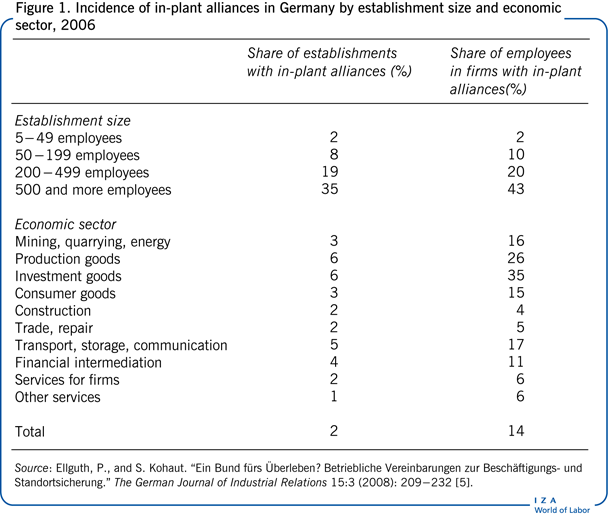Elevator pitch
In-plant alliances are plant-specific deviations from sectoral collective agreements related to wages and working time that are intended to hold down labor costs. These agreements enable firm-level reorganizations to respond to an imminent economic crisis or to improve competitiveness. They also encourage social partners to take greater responsibility for employment issues. Both unions and works councils agree to such contracts because they see them as helpful in avoiding severe employment losses. Thus, these alliances substantially unburden public employment policy.
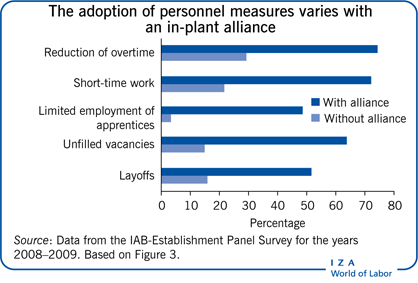
Key findings
Pros
In-plant alliances can help firms survive, save jobs, and foster employment.
Labor costs may be reduced due to in-plant alliances, thereby indirectly fostering increased employment.
More flexible working-time regulations and reorganizations as part of in-plant alliances increase both labor productivity and firm competitiveness, contributing to an increase in employment.
In-plant alliances encourage social partners to take greater responsibility for employment issues.
Cons
Labor markets may be distorted by in-plant alliances because they favor insiders over outsiders thereby reducing the employment chances of outsiders.
Employment expectations could be exaggerated if in-plant alliances are seen as bucking market trends.
Sectoral collective agreements may be eroded by in-plant alliances.
In-plant alliances cannot deviate “too much” from the collective agreement because unions would not agree to that.
Reductions in working time seem to be better implemented via other collective agreements such as sectoral- and/or firm-level agreements rather than through in-plant alliances.
Author's main message
Plant-specific deviations from a sectoral collective agreement (in-plant alliances) can be good for employees because wages agreed in sectoral collective agreements may lead to severe employment losses during an economic crisis or if in-plant restructuring is deemed necessary to sustain or improve competitiveness. Their specifically tailored wage concessions, as well as flexible working-time arrangements and reorganization, can be beneficial for employers—and in the long term for employees. Policymakers should thus encourage works councils and employers to conclude in-plant alliances with the consent of both unions and employers’ associations.
Motivation
During the global financial crisis of 2008–2009 many countries, including Germany, faced their deepest recession since the Great Depression. Although German GDP dropped 6.6% between 2008 and 2009, unemployment increased only modestly. Social cohesion, controlled unit labor costs, intelligent labor policy, and flexible management of working time helped companies retain personnel [1]. So-called in-plant alliances that allowed firms to deviate from sectoral collective wage agreements were especially powerful in avoiding dismissals. Combining several measures, these agreements reduced labor costs and enabled firm-level reorganizations. Before the crisis, such alliances improved firms’ competitiveness; thereafter, they helped to overcome the imminent economic crisis. The employee representatives consented to those agreements as a condition of the employment guarantees or investment decisions of the firms.
Since the 1990s, when they were first introduced, in-plant alliances have had serious effects on the system of industrial relations in Germany. Trade unions were in danger of losing their exclusive and genuine role with respect to employees’ collective bargaining power. An increasing number of in-plant alliances suggested a continuous, uncontrolled process of shifting the collective bargaining responsibility from trade unions to works councils. Additionally, since the 1990s, the coverage rate of industry-wide, multi-employer agreements has reduced considerably. Thus, the coverage rate in relation to employees in private establishments dropped from 66% to 41% in (former) West Germany and from 48% to 28% in (former) East Germany from 1996 to 2019. This dramatic decline influenced not only in-plant alliances but also the organization of work, including working time. Many employers not only deviated from sectoral collective agreements negotiated by unions and employers’ associations, but also “escaped” from their employers’ associations.
Discussion of pros and cons
Origins of in-plant alliances
During the 1980s, so-called concession bargaining gained importance in the US. It became popular because of increased international competition, wage pressure from sectors with low unionization, and deregulation of the US economy [2]. This led to a situation in which in-plant alliances meant, in some cases (but not all), that local unions had to accept wage reductions in exchange for short-term employment guarantees.
In 1990, the British government started to promote partnership agreements in both the private and public sectors [3]. The agreements were intended to modernize the public sector in response to the extension of markets, the rise in private finance, and the restructuring of public service provision. One-third of public sector employees have since been covered by such partnership agreements [3].
Since the early 1990s, explicit bargaining activities and agreements on employment and competitiveness have emerged in many EU countries. Activities at the national and regional levels have contained a wide range of economic, industrial, and social policy measures with the explicit aim of creating new jobs through reduced labor costs, more flexible labor markets, and improved workforce employability. Some countries were also trying to fulfill the conditions for membership of the European Currency Union [2], [3], [4].
In a number of countries, such as Germany after the deep recession of 1992–1993 and the failure of an attempted national “alliance for jobs” in 1996, agreements emerged at the sectoral level. Unions and employer associations included “opening clauses” or “hardship clauses” in collective agreements, allowing the in-plant actors to deviate temporarily from the standards of remuneration and working times agreed in industry-level bargaining. In exchange, employees received temporary guarantees of jobs. Note that the bargaining partners’ consent is required if corporations wish to undercut the standards specified in industry-level contracts.
Incidence and contents of in-plant alliances
The Establishment Panel Survey of the Institute for Employment Research (IAB) conducted in 2006 provides information on in-plant alliances with concessions from both employees and employers. Of all German establishments in the private sector with five or more employees, 2% had concluded such job alliances, covering 14% of the German workforce (Figure 1). The incidence of alliances depends strongly on establishment size. Only 2% of all establishments with fewer than 50 employees had adopted a job alliance; but, among establishments with 500 or more employees, 35% had concluded such an agreement [5]. Alliances were observed mostly in manufacturing; mining and energy; and transport, storage, and communication. In terms of the proportion of employees working in establishments with a job alliance, the investment goods industry was the most important sector [5].
Most of the employee concessions included in such alliances reduced special bonus payments, such as Christmas bonuses and holiday pay (62%), or introduced, extended, or re-regulated working-time accounts (53%) (Figure 2). Less important were reducing overtime work (41%) and suspending contractual wage increases (38%) [5]. The reduction of special bonus payments and the prolongation of working time without wage adjustments were both concluded more often in a crisis alliance than in a competitive alliance.
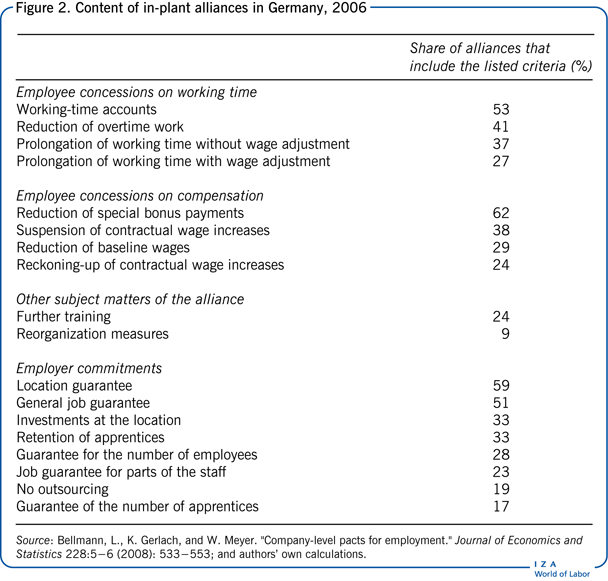
In the majority of alliances, the employer gave a location guarantee (59%) and/or a general job guarantee (51%), often also committing to invest at a plant location (33%) [5].
In-plant alliances feature combinations of different measures. But due to the large number of possible combinations, analysis does not reveal any combination that is used most frequently.
Arguments for and against concluding in-plant alliances
Strengthening competitiveness
In general, works councils representing employees conclude in-plant alliances with firm management to strengthen the competitive position of the company. Since an economic crisis can reduce labor's productivity, and since increased competition can force companies to restructure, management and works councils seek to avoid employee layoffs. Works councils concede to management proposals to increase the flexibility of labor use through, say, lowering wages and working-time measures. Works councils may also make agreements on performance-related wages, implying a reduction in baseline wages. In addition, the intensity of further training could be increased [6]. What these personnel policy instruments have in common is reducing the unit labor costs.
Dealing with a crisis
Both before and during the Great Recession of 2008—2009, employment development in crisis plants (those affected by the financial crisis) was much better if an in-plant alliance was concluded [7]. Interestingly, this finding contrasts with previous studies that only cover the period before the crisis. Figure 3 displays the measures taken by establishments hit by the Great Recession. Accordingly, establishments that relied on in-plant alliances were more likely to reduce overtime, adopt short-time work, increase working time (albeit insignificantly), limit employment of apprentices after having completed an apprenticeship, leave vacancies unfilled, and lay off employees.
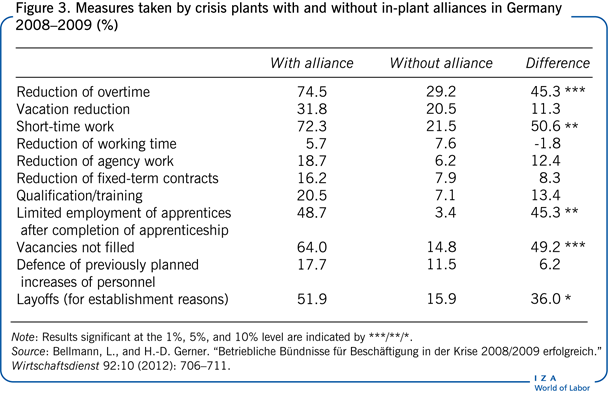
These results are in contrast to the recently concluded collective agreement between the German Metal Workers’ Union and the Employers’ Association of Metal Industries (Gesamtmetall) with an emphasis on individual options to reduce working time (since 2019) and the collective option for companies in need to do so (since 2021). Furthermore, in the collective agreement reached in 2021, a framework for future pacts about goals, staff requirements, and qualification/training is outlined.
Preserving workers with a vocational degree
Descriptive statistics reveal that the proportion of people with a vocational degree is much higher in establishments with an in-plant alliance than without one, irrespective of establishment size while the share of people without a vocational degree is lower. In establishments with fewer than 200 but more than 50 employees, the proportion of apprentices is considerably lower in companies with in-plant alliances (Figure 4).
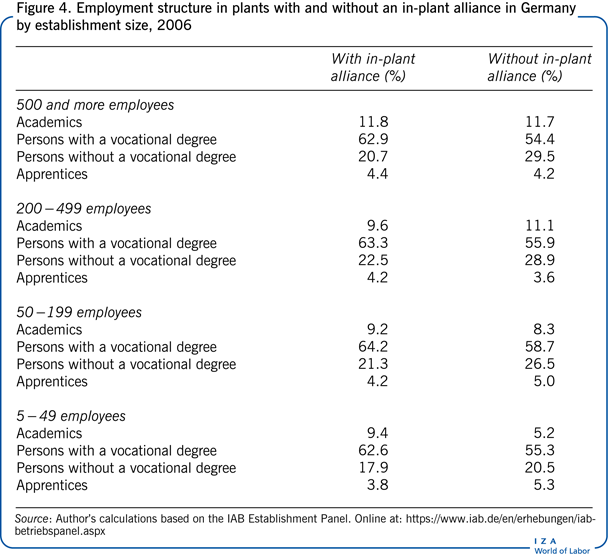
Insiders and outsiders
Arguments against in-plant alliances include the difficulty for management to fulfill its pledges, but there are some additional problems. The works council and management may be interested in saving only the jobs of workers already employed (“insiders”). Such action improves the competitive position of insiders but reduces the employment chances for outsiders.
Problems with implementing collective job agreements
Theoretically, bargaining partners can augment their utility and profit by negotiating wages and employment simultaneously. The resulting agreements reduce wages or prolong working times in exchange for employment guarantees or investment programs.
An “efficient” sectoral collective agreement cannot be enforced by employer associations because they cannot specify the employment level for each member firm. By contrast, bargaining simultaneously over wages and employment at the company level is more efficient, as firms reneging on their commitments would face problems with their works councils and the unions. Special “opening clauses” often allow firms to renegotiate their pledges. After some negative examples when the experience with in-plant alliances was limited, detailed contracts have been used for alliance implementation [8].
It may be difficult to conclude otherwise efficiency-enhancing bargaining contracts if the employed insiders use their bargaining power to resist management's interest in reducing wages, and to ignore the interest of unemployed outsiders [2]. In-plant alliances might have the advantage of taking into account the employment consequences of wage negotiations, but they cannot deviate too much from the results negotiated at the sectoral level, because the unions would not agree to them. Thus, employers cannot exploit the weaker bargaining position of works councils. Works councils also restrain themselves from wage bargaining in order to retain peaceful labor relations within the firm [6].
Enforcing pledges
Young apprentices are a special group of outsiders. In 33% of in-plant alliances, the employers committed themselves to retain apprentices after they had completed their vocational training, sometimes for only six months (Figure 2). But guarantees for the number of apprentices are less frequent (17%). These facts indicate that young labor market entrants are not considered a target group for in-plant alliances.
Furthermore, 24% of in-plant alliances contain an employer pledge for further training. In addition, employers’ general job and location guarantees—in exchange for works council wage concessions—tend to increase employment stability and thus the firms’ incentives for human capital investments. But empirical evidence suggests that in-plant alliances do not have a positive causal effect on further training [9].
At both national and sectoral levels, initiatives have run into difficulties because employer associations could not enforce their member firms’ pledges. In contrast, as single firms and locations are exposed to more competition, both from other establishments and from other workplaces of the same firm—as well as rights and responsibilities for wages, working time, and employment—employment security and location survival become more important in the bargaining agenda at firms and plants.
Pressure from multinationals
In-plant alliances are of special interest to multinational corporations. First, working arrangements are tailored to the company's needs. Second, performance can be measured and compared within the company. Third, with a shift of responsibility for and accountability of labor costs to business units, information from performance comparisons has been used to pressure works councils to concede to deviations from sectoral bargaining standards [10].
Partnerships or conflicts
The in-plant alliances in Germany exemplify a partnership between employers and employees. Acting as co-managers, union representatives gain additional power and responsibilities at the firm level. But political conflicts are created because some firms do not reach the employment objectives agreed on in the respective alliance [11].
In general, restructuring a company comes mostly from management in response to an imminent economic crisis or with the aim of increasing the company's competitiveness. Thus, the bargaining power of works councils seems to be relatively weak and gives management leeway for wage moderation to preserve employment during an economic crisis. The negotiation of such contracts seems less confrontational than US-type concession bargaining, with union-busting and avoidance strategies often associated with in-plant alliances, and job security not always exchanged for employee concessions.
Reducing the risk of failure of in-plant alliances
The dilemma with in-plant alliances is that works councils must agree to reduced wages and prolonged working time for a limited period because of an imminent or ongoing crisis. But employers cannot be sure they will be able to fulfill their pledge because of uncertainties about the future of their product market. For example, during the Great Recession of 2008–2009 firm management did not know how long the crisis would last or how much their revenues would decline. Thus, it was not clear whether in-plant alliances concluded before the start of the crisis could be continued, nor whether it was possible to conclude new job alliances. In-plant alliances of the first category had to be renegotiated and adapted because of the changed conditions. But employee representatives and firm management had more recent information about the probable development of the product market that increased the likelihood that employers could fulfill their pledges [11].
Better employer–employee relationships in firms and greater trust of works councils in management increase the chances that firms will fulfill employment guarantees. And if the members of works councils act as co-managers, job alliances fail less often. The effects of the firms’ export orientation, the existence of a sectoral collective agreement, and the necessity of the union's consent are insignificant [11].
Limitations and gaps
In-plant alliances differ in their goals, motives, measures, and economic sectors. Since the experiences and mutual trust of social partners are as important as legal regulations, it is difficult to draw definite conclusions about Germany's success for other countries. As explained, it may be possible under certain conditions to foster employment by concluding an in-plant alliance. But it remains open how employment, working time, and wages at the firm level would respond at the sectoral or aggregate level.
A key limitation of most investigations about the goals, contents, and successes of in-plant alliances is that they are not based on representative data for sectoral and firm size coverage. Many studies are based on cross-sectional data and thus cannot assess the employment effect over a longer period. Having detailed information about firms that did not conclude an in-plant alliance is also necessary to construct a control group for identifying the effects on the treatment group. Information on firms prior to the introduction of in-plant alliances could help control for any selection effects. Also of interest would be to know how long the in-plant alliances are in place, and which regulations agreed on are still valid when the alliances expire.
Summary and policy advice
More than 20 years ago in Germany the public debated whether union consent to in-plant alliances should be abolished, leaving works councils to decide by themselves how much they could deviate from collective agreements. The alliances can be regarded as an instrument to reduce wages and to cope with the challenges of global competition. But social partners wish to conclude in-plant alliances aligned with collective agreements. Works councils are interested in having union expertise in outlining in-plant alliances with detailed regulations, since vague pacts have in some cases failed. And the power of works councils is greater if they have the support of unions.
Empirical evidence based on representative establishment data for Germany reveals that during the 2008–2009 global financial crisis companies avoided dismissals by concluding in-plant alliances. But these pacts were not successful in reducing working time or increasing qualification/training and favored labor market insiders at the expense of outsiders.
In-plant alliances could be used with short-time work allowance schemes that draw heavily on government resources. But the maximum duration of short-time work allowances is limited, although it was extended in Germany from 12 to 24 months during 2008–2009, and the time needed for flexibility and in-plant restructuring may be much longer. In contrast to short-time work programs, in-plant alliances can help overcome an imminent crisis and have concrete personnel policies to improve firms’ competitiveness and employment prospects without relying on wage reductions.
Thus, policymakers should encourage social partners to conclude in-plant alliances that are aligned with both collective agreements and detailed regulations. Such alliances have been shown to be helpful in saving jobs in an economic crisis or if firms have to improve their competitiveness. These alliances are also in the government's interest because public expenditures for labor market policies can be reduced. Within the European Employment Strategy, the preservation and creation of jobs, as well as the achievement of competitiveness, are of crucial importance. In-plant alliances specifically link employment and competitiveness [2].
Acknowledgments
The authors thank two anonymous referees and the IZA World of Labor editors for many helpful suggestions on an earlier draft. Version 2 of the article explains that working time reductions may be better implemented by sectoral- or firm-level agreements, and includes a new figure, an updated “Graphical abstract,” and new “Additional references.”
Competing interests
The IZA World of Labor project is committed to the IZA Code of Conduct. The authors declare to have observed the principles outlined in the code.
© Lutz Bellmann and Werner Widuckel
